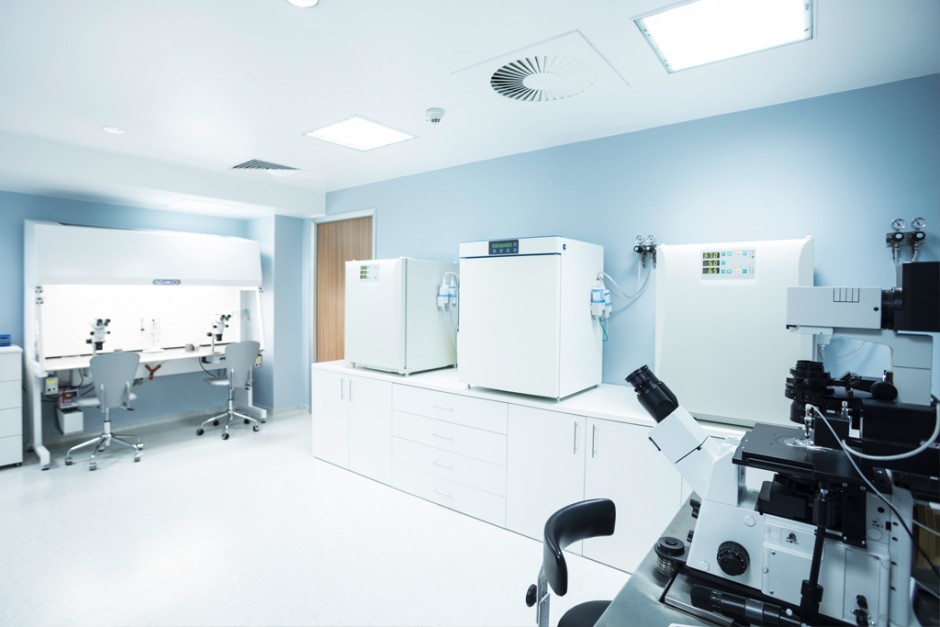Research and development cleanrooms that operate on a daily basis for pharmaceutical or electronics development organizations, among others, must maintain the sanctity of their cleanroom space with proper, professional and thorough cleaning—nothing less. Avoiding or improperly cleaning the controlled space can result in catastrophic cross contamination, wrongful results, lawsuits or worse.
When the success of a new product, process or patent is on the line, it pays to ensure your cleanroom is cleaned, sanitized and disinfected in the correct way—so as to actually disinfect, and to safeguard from outside contaminants that can be introduced through untrained or uneducated janitorial staff.
What Is a Cleanroom?
A cleanroom is a space that is preordained to be kept to a certain level of cleanliness. These spaces are free of dust and other particles in the air or on surfaces and are held to a rigorous standard of cleanliness. Other organizations use cleanrooms to conduct experiments containing bacteria, viruses and microbial agents. Not only can these invisible assailants contaminate the space in a cleanroom, but they can compromise the validity of future experiments and tests. For these reasons, proper disinfection and continual upkeep of a cleanroom is critical.
Depending on the type of production or research being carried out, cleanrooms will typically be given an ISO rating that considers factors such as air filtration, test methods and more to set standards for how “clean” the cleanroom needs to be, and to determine what kind of pharmaceutical, electronic or other tests and production it’s suited for. Based on the functions a cleanroom is cleared for, the chemicals and techniques used to clean and sanitize it will vary.
Choosing the Right Cleanroom Cleaning Products
There is a variety of different classifications and purposes that can dictate the correct methods and materials used to properly sanitize a cleanroom. All cleanrooms require review of the cleaning chemicals that will be used in the disinfecting process to ensure they will perform adequately. For higher grade cleanrooms (ISO 14644 classes 5 through 7) for example, sterile disinfectants are required. To choose the best cleaning products for a cleanroom, janitorial staff must use cleaning chemicals that are1:
- Non-ionic and chemically neutral
- Satisfy GMP regulations
- Non-foaming
Non-ionic and chemically neutral disinfectants and cleaners won’t interfere with an environment that may need a certain chemical composition or makeup for production, experiments or testing. If pharmaceutical products are being produced, Good Manufacturing Practice (GMP) regulations must be met by cleaning chemicals and disinfectants.
Foaming cleaners or disinfectants can cause buildup or stains on counters or other surfaces that need to be completely sterile for production or testing purposes. Higher grade cleanrooms must use disinfectants that come sterilized at purchase, or must be sterilized before use by janitorial staff.
How to Deliver Effective Cleanroom Cleaning
Any experiments or in-production materials should be properly stored before janitorial staff enters the cleanroom. If there are any materials left out by the room’s staff when cleaning is scheduled to begin, contact the appropriate party immediately, as pharmaceutical or electronic components are very fragile and prone to contamination.
Once all materials from cleanroom personnel have been properly stored, janitorial staff must suit up in sterile gowns before entering the cleanroom. Any large or visible debris should be swept into receptacles and disposed of properly. Disinfectants should be applied to counters, walls and floors and allowed to dry; a non-shedding cloth should be used for walls and counters and a sterile mop should be used for floors. Ventilation system grates should be disinfected as well, but internal components should not be accessed as some cleanroom ventilation systems are specially related to the function of the cleanroom. A professional cleaning service should be contacted in order to sufficiently clean the inner workings of specialty ventilation systems to avoid damage and save money and time.
It’s also worth considering electrostatic spray disinfection for cleanroom and R&D facilities, as electrostatic spray disinfection is a nonabrasive cleaning procedure that will maintain the controlled environment of the room. By using charged particles that evenly coat every surface, electrostatic spray disinfection is able to clean and disinfect nearly every surface in an R&D Facility or cleanroom.
Do you need to guarantee quality experimentation and production environments in your cleanroom or R&D facility? Contact the leading professionals in cleanroom cleanliness today.
Sources:

